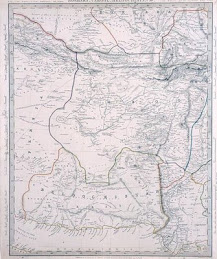Baluchistan
Balochistan was the site of the earliest known farming settlements upon the Iranian plateau bordering South Asia, the earliest of which was Mehrgarh dated at 6500 BCE Balochistan corresponds to the ancient Achaemenid province of Gedrosia. Balochistan was sparsely populated by various tribes, possibly of Dravidian and Indo-Iranian origin, for centuries following the decline of the nearby Harappa-Mohenjo-daro civilisation to the east. Over time, Balochistan was invaded by various Eurasian groups including the Aryans, Persians, Greeks, Kushans, Arabs, Turks, Mongols, Mughals, Afghans, and the British.
Islamic conquest of Baluchistan
In early 644, Caliph Umar sent Suhail ibn Adi from Busra to conquer the Kerman region of Iran; he was made governor of Kerman. From Kerman he entered the western Baluchistan and conquered the region near to Persian frontiers.[4] South Western Baluchistan was conquered during the campaign in Sistan the same year. During Caliph Uthman’s reign in 652, Baluchistan was re-conquered during the campaign against the revolt in Kerman, under the command of Majasha ibn Masood, it was first time when western Baluchistan came directly under the Laws of Caliphate and gave tribute on agriculture.[5]In those days western Baluchistan was included in the dominion of Kerman. In 654 Abdulrehman ibn Samrah was made governor of Sistan, an Islamic army was sent under him to crush the revolt in Zaranj, which is now in southern Afghanistan. Conquering Zaranj a column moved north ward to conquer areas up to Kabul and Ghazni in Hindu Kush Mountains, while another column moved towards North western Baluchistan and conquered area up to the ancient city of Dawar and Qandabil (Bolan),[6] by 654 the whole of what is now Baluchistan province of Pakistan was under the rule of Rashidun Caliphate except for the well defended mountain town of QaiQan (now Kalat), which was conquered during Caliph Ali’s reign. [7] Abdulrehman ibn Samrah made Zaranj his provincial capital and remained governor of these conquered areas from 654 to 656, until Uthman was murdered. During the Caliphate of Ali, the areas of Baluchistan, Makran again broke into revolt. Due to civil war in the Islamic empire Ali was unable to deal with these areas until 660 when he sent a large force under the command of Haris ibn Marah Abdi towards Makran, Baluchistan and Sind. Haris ibn Marah Abdi arrived in Makran and conquered it by force then moved north ward to north eastern Baluchistan and re-conquered Qandabil (Bolan), then again moving south finally conquered Qaiqan (Kalat) after a fierce battle[8]. In 663 during the reign of Umayyad Caliph Muawiyah I, Muslim lost control of North eastern Baluchistan and Kalat when Haris ibn Marah and large part of army died in the battle field against a revolt in Kalat.[9] Muslim forces latter re-gained the control of the area during Umayyads
reign. It also remained part of Abbasid Caliphate's empire.
history file; m.sarjov
Monday, April 14, 2008
Subscribe to:
Post Comments (Atom)










































No comments:
Post a Comment